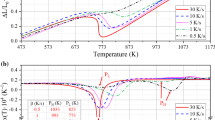Abstract
The paper analyzes the nucleation and growth of bainite in low-carbon low-alloy 09Mn2Si steel doped with titanium carbonitride nanoparticles in impact toughness testing. The analysis shows that such particles segregate at low-angle boundaries, retarding the formation of high-angle ones, and when impacted into the steel, they curve the lattice and generate a new bainite phase at the curvature interstices. The mechanism of bainite nucleation and growth is sympathetic, obeys the angular momentum conservation law, and provides the formation of multilayered packets of bainite plates capable for unlimited thinning to sub-sub-subunits during deformation. Such bainite plates can respond to their stress-strain state by one or another rotation, showing a high relaxation capacity and providing a high impact toughness of the steel at low temperatures.









Similar content being viewed by others
REFERENCES
Kovalchuk, M.V., The Arctic Development Issues a Challenge to Create Structural Materials with Brand New Service Properties, in Proc.Int. Conf.on Materials and Technologies for the Arctic, St. Petersburg: NRC Kurchatov Institute, CRISM Prometey, 2017, pp. 3–8.
Oryshchenko, A.S., The Modern Materials for the Arctic, in Proc. Int.Conf. on Materials and Technologies for the Arctic, St. Petersburg: NRC Kurchatov Institute, CRISM Prometey, 2017, pp. 9–11.
Panin, V.E., Derevyagina, L.S., Panin, S.V., Shugurov, A.R., and Gordienko, A.I., The Role of Nanoscale Strain-Induced Defects in the Sharp Increase of Low-Temperature Toughness in Low-Carbon and Low-Alloy Steels,Mater. Sci. Eng. A, 2019, vol. 768, p. 138491.
Schastlivtsev, V.M., Mirzaev, D.A., Yakovleva, I.L., Tereshchenko, N.A., and Tabatchikova, T.I., Effect of Increasing Impact Toughness on the Formation of a Layered Structure Upon Hot Rolling of a Ferritic Steel,Dokl. Phys., 2010, vol. 55, pp. 334−337.
Schastlivtsev, V.M., Tabatchikova, T.I., Yakovleva, I.L., Egorova, L.Yu., and Gervas’eva, I.V., Effect of Thermomechanical Treatment on the Cold Resistance of Low-Carbon Low-Alloy Welding Steel, Phys.Met. Metallogr., 2010, vol. 109, no. 3, pp. 289–299.
Farber, V.M., Khotinov, V.A., Morozova, A.N., Lezhnin, N.V., and Martin, T., Diagnosis of the Fracture and Fracture Energy of High-Ductility Steels in Instrumented Impact-Bending Tests, Met.Sci. Heat Treat., 2015, vol. 57, no. 5–6, pp. 329–333.
Farber, V.M., Khotinov, V.A., Belikov, S.V., Selivanova, A.V., Lezhnin, N.V., Morozova, A.N., Karabanalov, M.S., and Zhilyakov, A.Yu., Separations in Steels Subjected to Controlled Rolling, Followed by Accelerated Cooling, Phys. Met. Metallogr., 2016, vol. 117, pp. 407–421.
Derevyagina, L.S., Gordiyenko, A.I., Pochivalov, Yu.I., and Smirnova, A.S., Modification of the Structure of Low-Carbon Pipe Steel by Helical Rolling, and the Increase in its Strength and Cold Resistance, Phys.Met. Metallogr., 2018, vol. 119, pp. 83–91.
Panin, V.E., Egorushkin, V.E., Kuznetsov, P.V., Galchenko, N.K., Shugurov, A.R., Vlasov, I.V., and Deryugin, Ye.Ye., Structural Turbulence of Plastic Flow and Ductile Fracture in Low Alloy Steel under Lattice Curvature Conditions, Phys. Mesomech., 2020, vol. 23, no. 4, pp. 279–290.
Panin, V.E., Surikova, N.S., Panin, S.V., Shugurov, A.R., and Vlasov, I.V., Effect of Nanoscale Mesoscopic Structural States Associated with Lattice Curvature on the Mechanical Behavior of Fe–Cr–Mn Austenitic Steel,Phys. Mesomech., 2019, vol. 22, no. 5, pp. 382–391. https://doi.org/10.1134/S1029959919050059
Panin, V.E., Surikova, N.S., Smirnova, A.S., and Pochivalov, Yu.I., Mesoscopic Structural States in Plastically Deformed Nanostructured Metal Materials, Phys. Mesomech., 2018, vol. 21, no. 5, pp. 396–400. https://doi.org/10.1134/S102995991805003X
Turchanin, A.G. and Turchanin, M.A.,Thermodynamics of Refractory Carbides and Carbonitrides, Moscow: Metallurgia, 1991.
Averin, V.V., Revyakin, A.V., Fedorchenko, V.I., and Kozina, L.N., Nitrogen in Metals, Moscow: Metallurgia, 1976.
Dong, J., Liu, C., Liu, Y., Li, C., Guo, Q., and Li, H., Effects of Two Different Types of MX Carbonitrides on Austenite Growth Behavior of Nb–V–Ti Microalloyed Ultra High Strength Steel, Fus. Eng. Design, 2017, vol. 125, pp. 415–422.
Fang, H.S., Yang, J.B., Yang, Z.G., and Bai, B.Z., The Mechanism of Bainite Transformation in Steels, Scripta Mater., 2002, vol. 47, pp. 157–162.
Kuznetsov, P.V., Petrakova, I.V., Rakhmatulina, T.V., Baturin, A.A., and Korznikov, A.V., The Use of Scanning Tunneling Microscopy in Characterizing the Grain-Subgrain of SMC Nickel after Low-Temperature Annealing,Zavod. Lab.Diagn. Mater., 2012, vol. 78, no. 4, pp. 26–34.
Yang, Z.G. and Fang, H.S., An Overview on Bainite Formation in Steels, Curr. Opin. Solid State Mater. Sci., 2005, no. 9, pp. 277–286.
Fang, H.S., Bo, X.Z., and Wang, J.J., A Model for Surface Reliefs Formation in Bainite Transformation Mechanism,Mater. Trans. JIM, 1998, vol. 39, no. 12, pp. 1264–1271.
Wang, J.-J., Fang, H.-S., Yang, Z.-G., and Zheng, Y.-K., Fine Structure and Formation Mechanism of Bainite in Steels, ISIJ Int., 1995, vol. 35, no. 8, pp. 992–1000.
Wang, J.-J., Fang, H.-S., Zheng, Y.-K., and Yang, Z.-G., Use of Scanning Tunneling Microscopy in Metallography, Mater. Charact., 1994, vol. 33, pp. 169–174.
Spanos, G., Fang, H.S., and Aaronson, H.I., A Mechanism for the Formation of Lower Bainite, Metall. Trans. A, 1990, vol. 21, pp. 1381–1390.
Funding
The work was performed under Fundamental Research Program of the State Academies of Sciences for 2013–2020 (project III.23.1.1 project), RFBR project No. 17-01-00691, and SB RAS integration project No. II.1.
Author information
Authors and Affiliations
Corresponding author
Additional information
Russian Text © The Author(s), 2019, published in Fizicheskaya Mezomekhanika, 2019, Vol. 22, No. 5, pp. 19–27.
About this article
Cite this article
Kuznetsov, P.V., Panin, V.E. & Galchenko, N.K. Hardening Mechanism in Low-Carbon Low-Alloy Steels with a Simultaneous Increase in Ductility and Fracture Toughness. Phys Mesomech 23, 347–353 (2020). https://doi.org/10.1134/S1029959920040098
Received:
Revised:
Accepted:
Published:
Issue Date:
DOI: https://doi.org/10.1134/S1029959920040098




